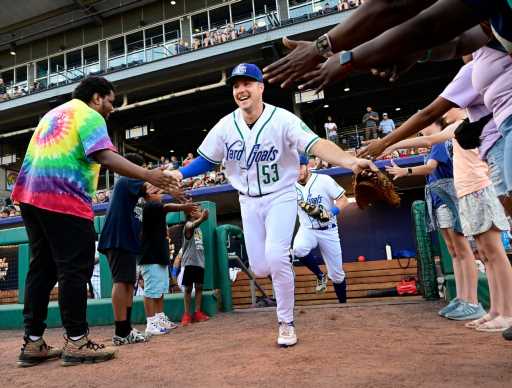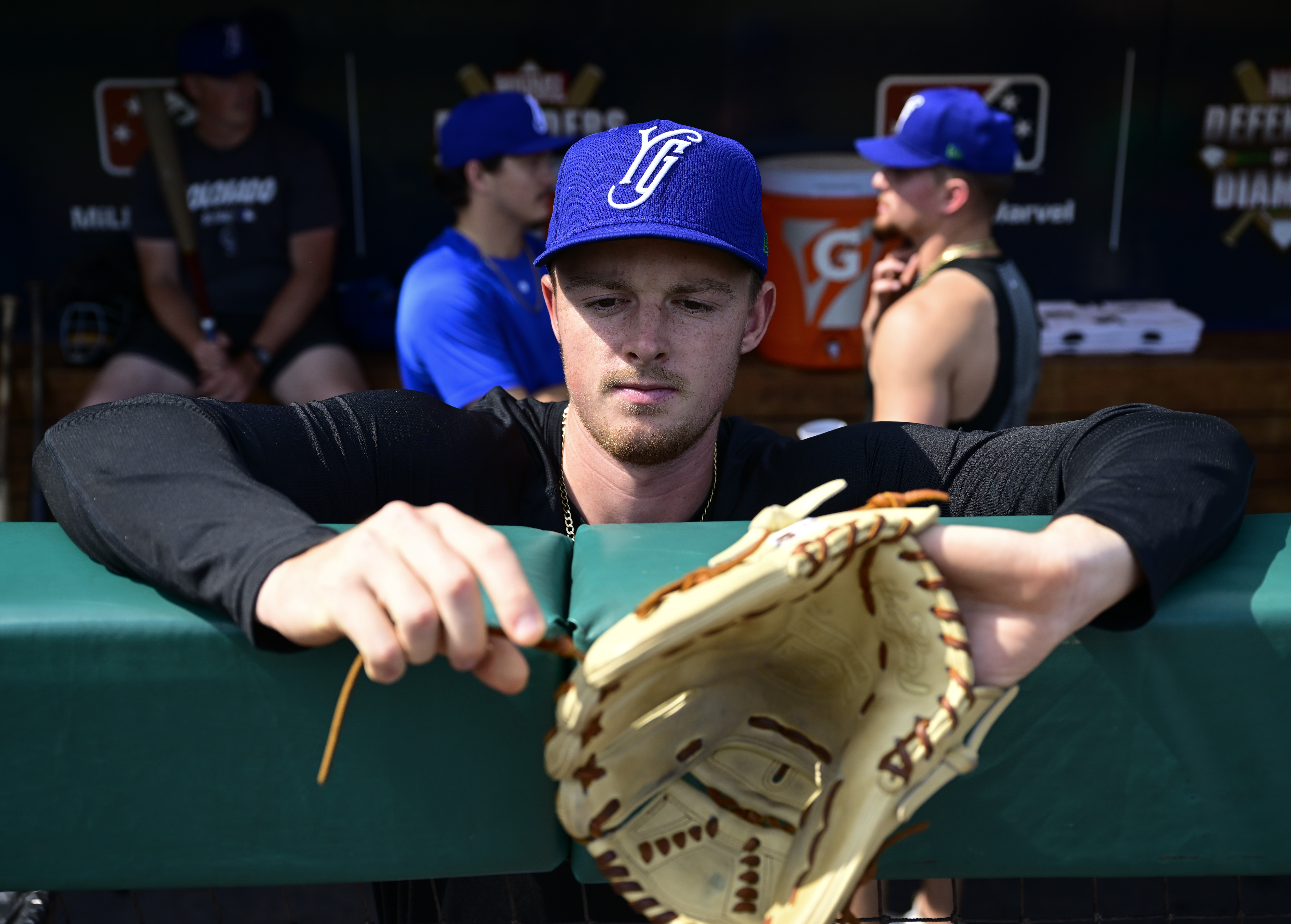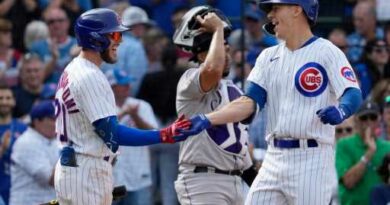Draft-and-build Colorado Rockies farm behind in pitching, analytics
Before a Double-A game in August, Drew Romo worked in his new mitt in the Hartford dugout, pounding his glove with a quiet confidence, as if waiting on his moment to become the Rockies’ catcher.
A few minutes later, outfielder Jordan Beck popped up in the dugout and grabbed some lumber, twisting it in his hands ahead of batting practice, swaying it back and forth, ready to mash something at Coors Field tomorrow.
Those two top prospects weren’t worried about what was going on in Denver, where the Rockies were on their way to bottoming out with their first 100-loss season in franchise history. To Romo, Beck and other big names on the Colorado farm, optimism is the tone, and forward is the vision.
Can these promising positional prospects, pitching depth be damned, make the Rockies competitive again sometime soon?
“No question,” Romo said confidently.
“My goal coming into pro ball is not to lose, I’ll tell you that,” Beck added a few minutes later.
The organization’s confidence in the future stands in stark contrast with the reality of the present, as the Rockies are mired in a five-year playoff drought. As Kyle Freeland and his teammates keep “looking for that light” at the end of a long and dark tunnel in LoDo, Colorado has a handful of positional prospects who might be able to provide it.
But the Rockies’ pitching depth lags beneath the MLB mean. If that doesn’t get addressed, the club won’t have the arms to match the bats when a competitive window presented by shortstop Ezequiel Tovar, outfielder Zac Veen, Romo, Beck and others opens.
It’s a dearth the Rockies are rapidly attempting to address as they’ve drafted and traded for a handful of pitching prospects, and reimagined their philosophy when it comes to drafting and developing arms for success at mile-high elevation.
The club’s pitching strategy was once defined by experimentation (Mike Hampton free-agent mega-deal in 2001), then morphed into a sinker-slider focus. But recently, Colorado decided that stockpiling a variety of arms is better than hoarding one specific subset.
“We’re trying to develop more of a contrast approach than five, 10, 12 years ago in this organization, when it was (a lot of) sinker-slider,” farm director Chris Forbes said. “We have to recognize who can pitch at the top of the zone and who has to stay at the corners and the bottom, but ultimately, we’re letting these guys be themselves.”
There is tangible proof in the Rockies’ new approach on the 40-man roster. But according to several prospects within the organization, there might be some cracks in it, too.
For one, Colorado’s organizational velocity is low compared to the rest of MLB. The Rockies rank last in baseball in average velocity this season at 92.5 miles per hour, while the Dodgers are tops in the division (and 16th in baseball) at 94.2. Colorado’s lack of overall gas also extends to its farm.
Multiple prospects also said that the Rockies need to have more of a concrete plan for each subset of pitchers they are drafting.
“If you look at (Double-A) Akron with the Guardians, every single one of their guys throws a riding vertical fastball cutter-type, so they pretty much all have the same style of pitch,” said one Rockies prospect, who spoke on condition of anonymity because he still plays in the organization. “Just like with the Yankees — hard fastballs at the top, cutters and big sliders off of it. Both the Guardians and the Yankees have a clear pitching plan with their approach and execution.
“Every single guy out of our ‘pen is a different kind of execution. Some guys are throwing sinkers at the bottom, some guys are throwing to the top. We need a better plan in total — all the sinker guys need to have the same plan. All the hard-throwers/vertical guys need to have the same plan. So you can have your variety, but we need to break it into (specialized) sections.”
Draft-and-build ethos
While the Rockies hope their restocking of pitching prospects and widened focus on development will pay off, Colorado’s draft-and-build strategy is reflected in the data since Rocktober.
When analyzing drafts from 2008 to 2021 (the last two drafts still TBD), Rockies picks have the highest WAR contributions for their own club (2.62 average) and overall (3.39). Colorado has also produced the most multiyear starters (15) and is tied for the most all-star nominations (12) among NL West teams.
But the Rockies also have the lowest overall hit rate of picks becoming major leaguers at 13.57%. While the Rockies need their top prospects to make the bigs, the Dodgers and Padres use the draft as asset acquisition that they can flip for big-league talent. L.A. and San Diego have the highest overall hit rates with their picks since Rocktober at 17.55% and 17.45%, respectively, but the lowest hit rate with their own club within the West at 8.59% and 8.63%.
San Diego, amid its minor-league firesale in recent years, is the antithesis of the Rockies. The Padres have traded/waived 173.5 in WAR since Rocktober, and they’ve produced 48 big-leaguers for their own club but 49 for others. Meanwhile, Colorado rarely trades away premium prospects and makes very few deals for big-leaguers in their prime.
What this means is that the Rockies — who have had recent big misses in free agency like Ian Desmond and Kris Bryant — are operating with a much slimmer margin of error. Colorado’s farm system is currently ranked 18th by MLB Pipeline and 20th by Baseball America.
The good news is, head of international scouting Rolando Fernandez and the club are making inroads in Latin America, as evidenced by rotational pillar Antonio Senzatela, rookie shortstop Ezequiel Tovar and the organization’s current top two prospects, infielder Adael Amador and outfielder Yanquiel Fernandez.
“If you’re comparing them to the Dodgers (on the international market), that’s probably not fair, but the Rockies are active,” said Jonathan Mayo, MLB Pipeline senior writer and author of “Smart, Wrong, and Lucky.” “They’re not afraid to spend on the international market and go out and get good players. Amador and Fernandez in particular have a lot of upside … and both could be in the big leagues next year at age 21.”
Catching up in analytics
As the Rockies attempt to rediscover their identity through the draft, they’re also trying to make up ground in the development phase, specifically in regards to analytics.
Colorado prospects say there’s been a heightened emphasis placed on getting digestible data in front of players on a daily basis. For the first time this season, the Rockies had a video/analytics coordinator at every level of the organization, and all of them traveled with the team.
“We’re using and seeing more data,” Rockies bullpen prospect Blake Goldsberry said. “I get reports after every outing from the analytics side, which is new this year, and when coordinators come into town we’ll have individual meetings with them on reports of where our stuff plays best at each park. In the past, we didn’t have that.”
The club is also constructing an analytics-specific building called “The Lab” at Salt River Fields in Scottsdale, where Forbes said “everything that’s sexy and shiny will be.” It’s scheduled to open in December.
But the Rockies remain behind the curve. The majority of MLB teams already have their own version of The Lab (Colorado had a temporary lab set up in the cages the past few seasons). And the Rockies still trail in terms of pure manpower in the research and development department.
According to Four Rings Sports Solutions, the Rockies are tied with the Marlins with the second-smallest department in baseball at 11 staffers as of August. By comparison, the Rays have the biggest at 44, followed by the Yankees (43) and Dodgers (35). Elsewhere in the NL West, the Giants have 21, the Diamondbacks 15 and the Padres 14.
But Forbes, Wallace and the Rockies say the organization is on the right track, even if the Rockies are outnumbered on the Moneyball side. Colorado hasn’t had a draft class produce double-digit WAR since 2014, when the Rockies took southpaw Kyle Freeland at No. 8 overall, but believe internally that the last couple of pitching-heavy classes can accelerate the rebuild.
“We’re doing it with a balance between traditional and (new-age analytics) approach,” Fobes said. “And with that, we’re trying to get back into that (competitive) window.”
“Uphill sledding”
For an organization whose future is its currency, this summer’s rash of pitching injuries stings.
The Rockies saw their rotation in tatters from spring onward due to injury, including Tommy John surgeries to Senzatela and fellow right-hander German Marquez. Colorado had three top starting pitching prospects undergo Tommy John, too: Gabriel Hughes, Jackson Cox and Jordy Vargas.
When the club’s big-league pitching attrition occurred, the Rockies didn’t have enough MLB-ready arms in the upper minors to fill the void. Hence selecting 30 pitchers (28 of them college arms) across the last two drafts, plus a flurry of trade-deadline moves that saw the Rockies flip five veterans for seven pitching prospects.
“They have to hope the extra focus on adding pitching will provide dividends,” Mayo said. “Sometimes, you just need to bring in quantity, and hope quality comes out of it, and that’s where they’re at right now.”
Rockies general manager Bill Schmidt isn’t making any guarantees for the future, but he believes the team is “setting the system up to have a pretty good foundation.”
“We’ve tried to build a foundation any way we can, to be able to support a championship-type club,” Schmidt said. “Ideally you want to match (hitting talent with pitching talent), and we’ve had some injuries, and that happens. … But we’re looking forward to continuing to get some young players up here (at Coors Field).”
Mayo struck a more tempered tone, projecting it will be “uphill sledding” for Colorado to catch up with the rest of its division. The Rockies have made the playoffs in consecutive seasons only once, 2017 and ’18, which is also the last time Colorado reached the postseason.
“Some of (the odds being against them) is because of the circumstances of the division they’re in — they could probably commiserate with some teams in the AL East in that regard because of the depth (of the West),” Mayo said. “You’ve got four other teams who are very competitive or trying to be competitive. … That, combined with some scouting and development misses, have the Rockies a little bit behind. The to-be-determined part is whether the recent efforts bear fruit.”
Want more Rockies news? Sign up for the Rockies Insider to get all our MLB analysis.
Share this:
- Click to share on Facebook (Opens in new window)
- Click to share on Reddit (Opens in new window)
- Click to share on Twitter (Opens in new window)
- Policies
- Report an Error
- Contact Us
- Submit a News Tip
- 2023
- September
- 28
Source: Read Full Article










